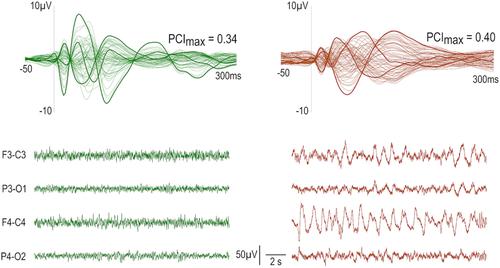当前位置:
X-MOL 学术
›
Eur. J. Nerosci.
›
论文详情
Our official English website, www.x-mol.net, welcomes your feedback! (Note: you will need to create a separate account there.)
Dissociations between spontaneous electroencephalographic features and the perturbational complexity index in the minimally conscious state
European Journal of Neroscience ( IF 3.4 ) Pub Date : 2024-03-05 , DOI: 10.1111/ejn.16299 Silvia Casarotto 1, 2 , Gabriel Hassan 1 , Mario Rosanova 1 , Simone Sarasso 1 , Chiara‐Camilla Derchi 2 , Pietro Davide Trimarchi 2 , Alessandro Viganò 2 , Simone Russo 1 , Matteo Fecchio 3 , Guya Devalle 2 , Jorge Navarro 2 , Marcello Massimini 1, 2 , Angela Comanducci 2, 4
European Journal of Neroscience ( IF 3.4 ) Pub Date : 2024-03-05 , DOI: 10.1111/ejn.16299 Silvia Casarotto 1, 2 , Gabriel Hassan 1 , Mario Rosanova 1 , Simone Sarasso 1 , Chiara‐Camilla Derchi 2 , Pietro Davide Trimarchi 2 , Alessandro Viganò 2 , Simone Russo 1 , Matteo Fecchio 3 , Guya Devalle 2 , Jorge Navarro 2 , Marcello Massimini 1, 2 , Angela Comanducci 2, 4
Affiliation

|
The analysis of spontaneous electroencephalogram (EEG) is a cornerstone in the assessment of patients with disorders of consciousness (DoC). Although preserved EEG patterns are highly suggestive of consciousness even in unresponsive patients, moderately or severely abnormal patterns are difficult to interpret. Indeed, growing evidence shows that consciousness can be present despite either large delta or reduced alpha activity in spontaneous EEG. Quantifying the complexity of EEG responses to direct cortical perturbations (perturbational complexity index [PCI]) may complement the observational approach and provide a reliable assessment of consciousness even when spontaneous EEG features are inconclusive. To seek empirical evidence of this hypothesis, we compared PCI with EEG spectral measures in the same population of minimally conscious state (MCS) patients (n = 40) hospitalized in rehabilitation facilities. We found a remarkable variability in spontaneous EEG features across MCS patients as compared with healthy controls: in particular, a pattern of predominant delta and highly reduced alpha power—more often observed in vegetative state/unresponsive wakefulness syndrome (VS/UWS) patients—was found in a non-negligible number of MCS patients. Conversely, PCI values invariably fell above an externally validated empirical cutoff for consciousness in all MCS patients, consistent with the presence of clearly discernible, albeit fleeting, behavioural signs of awareness. These results confirm that, in some MCS patients, spontaneous EEG rhythms may be inconclusive about the actual capacity for consciousness and suggest that a perturbational approach can effectively compensate for this pitfall with practical implications for the individual patient's stratification and tailored rehabilitation.
中文翻译:

最低意识状态下自发脑电图特征与微扰复杂性指数之间的分离
自发脑电图 (EEG) 分析是评估意识障碍 (DoC) 患者的基石。尽管即使在无反应的患者中,保留的脑电图模式也高度提示意识,但中度或严重异常的模式很难解释。事实上,越来越多的证据表明,尽管自发脑电图的 delta 活动较大或 alpha 活动减少,但意识仍然存在。量化脑电图对直接皮质扰动反应的复杂性(扰动复杂性指数[PCI])可以补充观察方法,并提供可靠的意识评估,即使自发脑电图特征不确定。为了寻求这一假设的经验证据,我们在康复机构住院的同一群最低意识状态 (MCS) 患者 ( n = 40) 中比较了 PCI 和 EEG 频谱测量。我们发现,与健康对照相比,MCS 患者的自发脑电图特征存在显着差异:特别是,在植物人状态/无反应觉醒综合征 (VS/UWS) 患者中更常见的是 δ 占主导地位和 α 功率高度降低的模式。在不可忽视数量的 MCS 患者中发现。相反,所有 MCS 患者的 PCI 值总是低于外部验证的意识经验临界值,这与存在清晰可辨(尽管短暂)的意识行为迹象相一致。这些结果证实,在一些 MCS 患者中,自发脑电图节律可能无法确定实际的意识能力,并表明扰动方法可以有效地弥补这一缺陷,对个体患者的分层和定制康复具有实际意义。
更新日期:2024-03-05
中文翻译:

最低意识状态下自发脑电图特征与微扰复杂性指数之间的分离
自发脑电图 (EEG) 分析是评估意识障碍 (DoC) 患者的基石。尽管即使在无反应的患者中,保留的脑电图模式也高度提示意识,但中度或严重异常的模式很难解释。事实上,越来越多的证据表明,尽管自发脑电图的 delta 活动较大或 alpha 活动减少,但意识仍然存在。量化脑电图对直接皮质扰动反应的复杂性(扰动复杂性指数[PCI])可以补充观察方法,并提供可靠的意识评估,即使自发脑电图特征不确定。为了寻求这一假设的经验证据,我们在康复机构住院的同一群最低意识状态 (MCS) 患者 ( n = 40) 中比较了 PCI 和 EEG 频谱测量。我们发现,与健康对照相比,MCS 患者的自发脑电图特征存在显着差异:特别是,在植物人状态/无反应觉醒综合征 (VS/UWS) 患者中更常见的是 δ 占主导地位和 α 功率高度降低的模式。在不可忽视数量的 MCS 患者中发现。相反,所有 MCS 患者的 PCI 值总是低于外部验证的意识经验临界值,这与存在清晰可辨(尽管短暂)的意识行为迹象相一致。这些结果证实,在一些 MCS 患者中,自发脑电图节律可能无法确定实际的意识能力,并表明扰动方法可以有效地弥补这一缺陷,对个体患者的分层和定制康复具有实际意义。



























 京公网安备 11010802027423号
京公网安备 11010802027423号